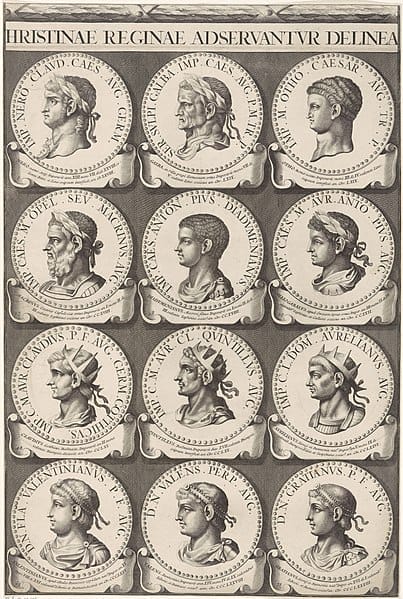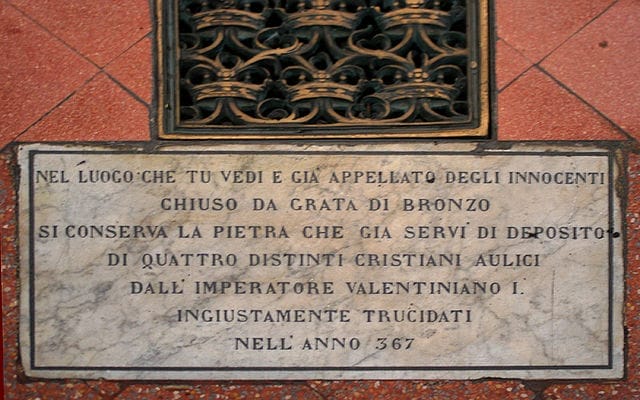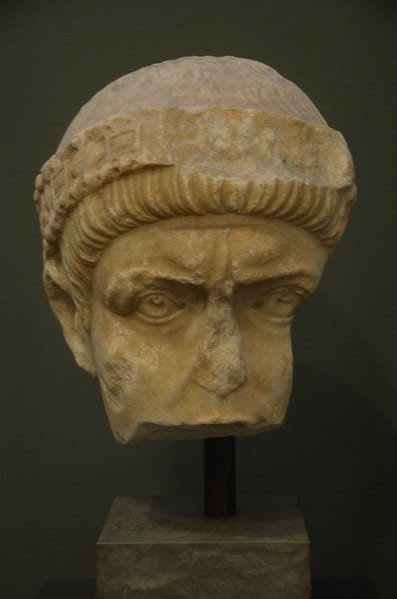Life: AD 321 – 375

- Name: Flavius Valentinianus
- Born in AD 321 at Cibalae, Pannonia.
- Became emperor early in AD 364.
- Wives: (1) Marina Severa (one son; Flavius Gratianus); (2) Justina (one son; Flavius Valentinianus).
- Died in Brigetio along the Danube on 17 November AD 375.
Early Life
Valentinian was born in AD 321 in Pannonia. His father was a certain Gratianus who came from Cibalae in Pannonia. The young Valentinian received a good education, even receiving training in painting and sculpture, arts for which he was to display much talent. After a military career, he came to serve as a military tribune under Constantius II in Mesopotamia (ca. AD 360) and later commanded a troop of spearmen under Julian. Though, in AD 362, Julian sent him into exile to Thebes in Egypt for his Christianity.
At Julian’s death, Jovian soon recalled him and ordered him to deal with mutinous troops in Gaul. A hazardous assignment that he was only able to accomplish after considerable trouble and significant risk to his own life. His reward was to be given command of the heavy infantrymen within the imperial household troops (scutarii).
Becoming an Emperor
At the death of Jovian, the commanders of the army withdrawing from its Mesopotamian campaign, having reached Nicaea with the main force, held a council with some civic leaders to choose a new emperor. Together, they decided on Valentinian, who was still at Ancyra (Ankara) at the time (AD 364). No sooner hailed emperor, he appointed his younger brother Valens as co-Augustus to rule over the east while he would govern the west.

Had there been previous divisions of the empire into eastern and western parts, then it had always been eventually unified again. This division, though, between Valentinian and Valens proved to be final. For a short time, the empires should run in harmony. And indeed, under Theodosius, they would even be briefly reunited again. However, it was this division that is looked upon as the defining moment when East and West established themselves as separate realms.
Western and Eastern Realm
Valentinian chose the western part for entirely unselfish reasons, not seeking the richer and larger part. In fact, the East possessed the greater resources. But the threat to the West was by far the greater one, and hence, Valentinian chose to give it his personal attention. The division was such that the diocese of Pannoniae and everything west of it was under the control of Valentinian, and the rest of the Balkans and the east fell to Valens.

Valentinian quickly saw the need to strengthen the military in order to deal with the enormous threats arising in the north. For this, he tried to raise the status of the soldiers. Money was hard to come by, so he instead distributed seeds and stock among them, allowing them to act as farmers in their spare time to supplement their income.
Barbarian Invasions
No sooner had he taken control of the West and set up his headquarters at Mediolanum (Milan), the empire saw a series of barbarian invasions. First to come were the Alemanni, crossing the Rhine and capturing the strategic bastion of Moguntiacum (Mainz). However, they were eventually defeated in three successive battles by Valentinian’s ‘Master of Horse’, Flavius Jovinus.
Realizing the need to be close to the points of crisis, Valentinian moved his headquarters to Lutetia (Paris) and in AD 367 yet further north to Samarobriva (Amiens), from where he oversaw operations on the Rhine and directed campaigns in Britain against Saxons and Picts invading the British provinces. Later, in AD 367, he moved once more, this time to Treviri (Trier), from where he marched a large army up the valley of the river Neckar and achieved victory in a hard-fought battle in the Black Forest.

Co-Augustus Gratian
In the same year, AD 367, Valentinian appointed his elder son Gratian as co-Augustus in the West. It was to prove a highly successful attempt to launch a new dynasty, for the ‘House of Valentinian’ should be a long-lasting one. Even the brief emperor Olybrius in AD 472 should still be a distant descendant of Valentinian and his second wife, Justina.
To pay for the great military efforts required during his time, Valentinian saw himself forced to introduce the highest, most oppressive Roman taxes so far. However, he did so reluctantly and with sincere concern for the poor.
‘Defender of the People’
In an attempt to share the financial burdens more justly, he made great efforts to ensure that the privileged few would no longer avoid paying their taxes. He also created the office of ‘Defender of the People‘ – the role of which was to assist the poor. In every town, such a Defender was appointed, empowered to protect the interests of the poor from infringements by the privileged classes.

Allegiance with Barbarians
In religious matters, Valentinian was a Christian but a leader of far less religious fervor than any of his immediate predecessors. His reign, hence, was based on a policy of broad religious tolerance. Valentinian stayed in Germany for no less than seven years, creating elaborate defensive systems along the Rhine and forging allegiances with various barbarian tribes. For example, he allied himself with the Burgundians, who were the traditional enemies of the Alemanni. At this time, he also settled numerous peaceable Germans on his side of the river.
Valentinian Sudden Death
The next invasion followed in AD 374 as, in the east of Raetia, Germans, and Sarmatians crossed the Danube together to meet his forces. In AD 375, Valentinian responded by moving his headquarters to Sirmium. He successfully drove the barbarians back across the river, reinforced the defenses, and crossed to the other side of the Danube, devastating the adjourning German territories.
Later the same year, some German delegates arrived to negotiate at Brigetio, but their behavior enraged him so much that he collapsed and died, most likely having suffered a heart attack (17 November AD 375).
People Also Ask:
Was Valentinian I a good emperor?
Despite his achievements, Valentinian was portrayed by the great pagan historian Ammianus Marcellinus as far beneath Julian in being angry, cowardly, and superstitious. Jerome portrays him as tolerant, brave, and responsible. He was a good administrator and is noteworthy for having persecuted neither pagans nor Arians.
What Roman emperor died of anger?
Valentinian became so angry that a blood vessel in his brain exploded, killing him instantly. He would be known as the last great Western Emperor to rule an empire at peace.
What was Emperor Valentinian I Known for?
Most notable was his victory over the Alamanni in 367 at the Battle of Solicinium. His general, Count Theodosius, defeated a revolt in Africa and the Great Conspiracy, a coordinated assault on Roman Britain by Picts, Scots, and Saxons.
Which Roman emperor died shouting?
This attitude so enraged Valentinian that on 17 November 375, while angrily yelling at the envoys, he suffered a fatal stroke. As was the custom, he was deified – becoming known as Latin: Divus Valentinianus Senior, lit. ‘the Divine Valentinian the Elder’.
Why was Valentinian so angry?
At an audience with envoys from the Germanic Quadi tribe – who were disgruntled that the empire was building fortifications in their territory – Valentinian became so enraged with their attitude that he burst a blood vessel in his head while screaming at them.

Historian Franco Cavazzi dedicated hundreds of hours of his life to creating this website, roman-empire.net as a trove of educational material on this fascinating period of history. His work has been cited in a number of textbooks on the Roman Empire and mentioned on numerous publications such as the New York Times, PBS, The Guardian, and many more.
